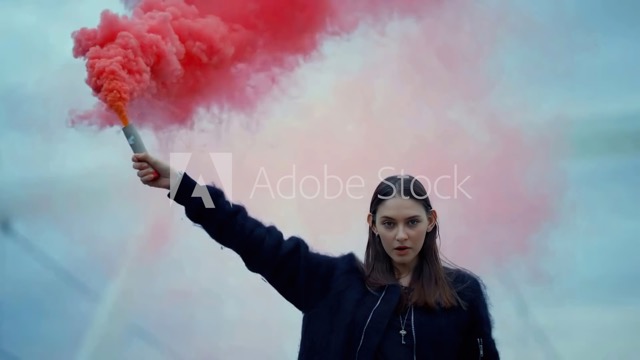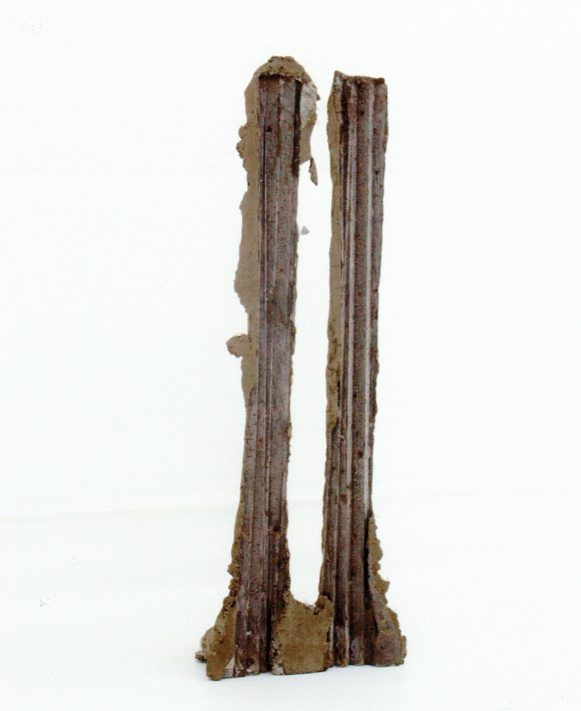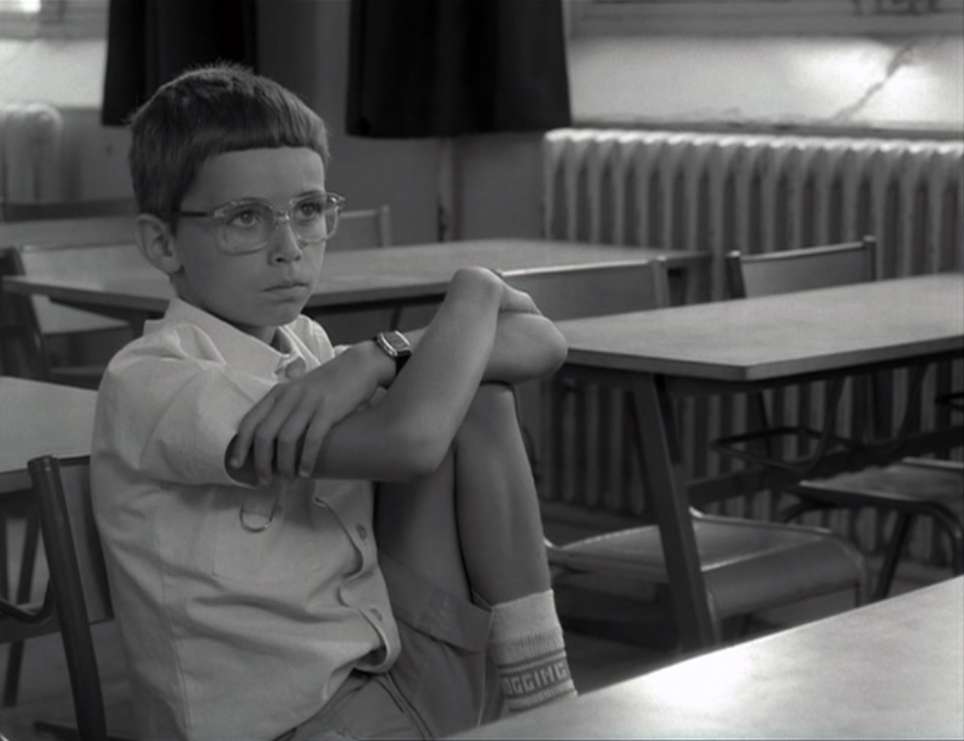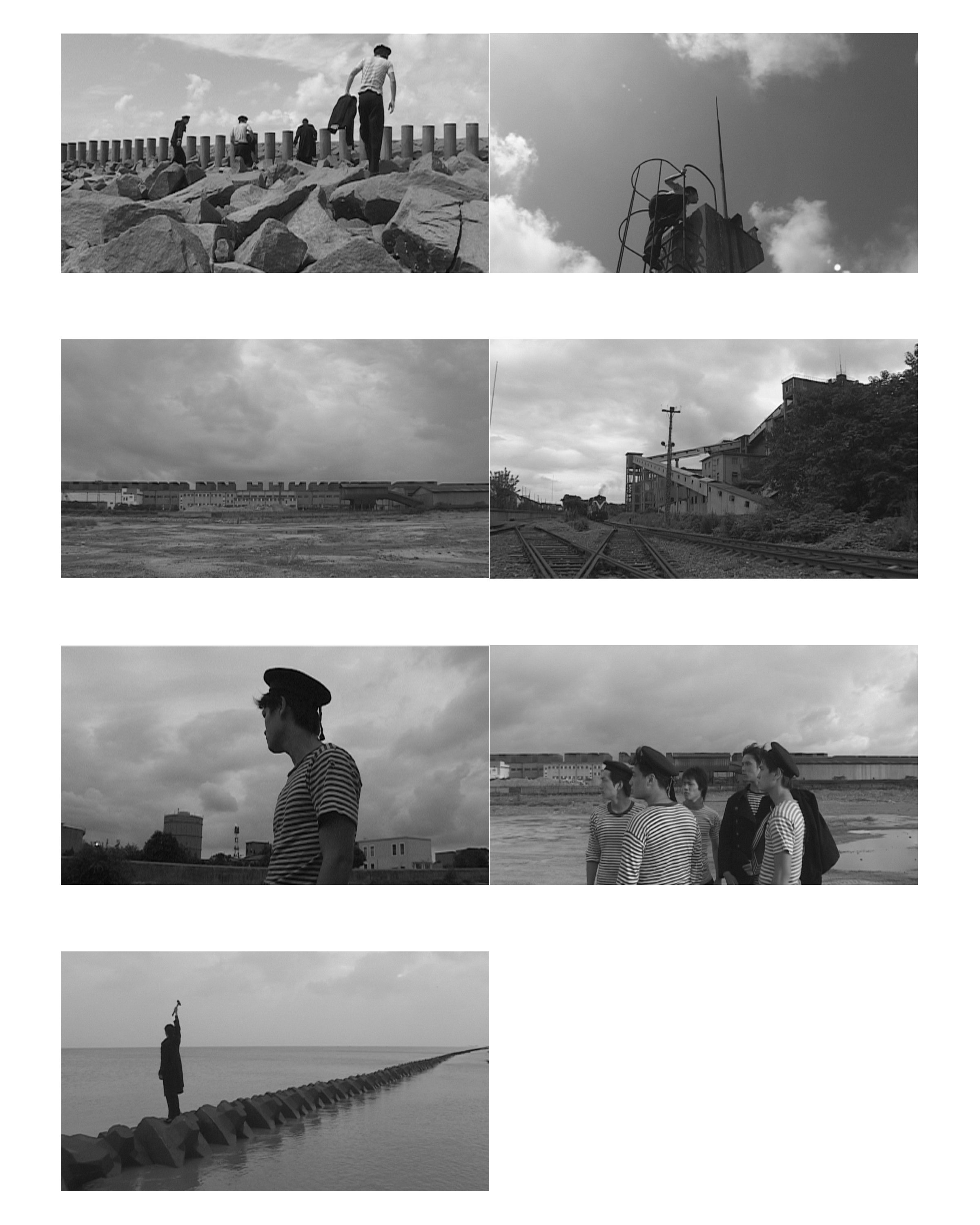
© » KADIST
Jean-Luc Moulène
It rains, Paris, 1st July 2000 , which could be the refrain of a song, is the title of a photograph of a minimal moment, the vision of a Parisian pedestrian, a cut flower lying on the pavement covered in rain drops. Is this moment captured by chance or a mise en scène? There is a sort of hiatus in the image; the planes – motif and background – connect nature in full bloom, pure, fragile, ephemeral with the grey weighty tarmac.

© » KADIST
Jean-Luc Moulène
Drawing & Print (Drawing & Print)
On a piece of paper, the artist has traced two loops in black crayon and placed two eyes where the lines intersect. Cut out of the same photograph, the eyes belong to the same gaze. The first asset of a slip knot is its simplicity, it basically requires a small length of rope.

© » KADIST
Jean-Luc Moulène
Head Box by J ean-Luc Moulène i s not the representation of a space but a real space that remains in the domain of sculpture which the artist develops in parallel with his photographic practice. Created for an exhibition in Kitakyushu in Japan, it is painted green, a color that symbolizes life and creation in Japanese culture. Even though we are confronted with a hollow presence, this is above all a space to lodge a body in the vertical posture of the living.

© » KADIST
Jean Claracq
View From an Apartment features 18-year-old Joland Novaj whose image was taken from Instagram. Staring vacantly at his cereal bowl, his computer is open on his own Instagram account and Steinbeck’s “Grapes of Wrath” lies open next to it, illustrated with a XV century illumination. Beyond the room there is a bay, lined with modernist buildings.

© » KADIST
Jean-Charles de Quillacq
Adam is an emblematic work within Jean-Charles de Quillacq’s oeuvre. The artist has created a number of pieces entitled Adam , referring to original man, incarnated in multiple objects at once. Materially, Adam is a fluorescent yellow walking rope with an epoxy coating on one side, rendering the structure rigid, demonstrative of his sculptural practice which is both conceptual and sensual.

© » KADIST
Danielle Dean
In True Red Ruin (Elmina Castle) , Danielle Dean uses archival documents to re-imagine colonial history from the 1400s, while also referencing her own personal history. Elmina Castle was built in Ghana in 1482 as a Portuguese trading post, and later became a key location in the Atlantic slave trade. Dean’s re-enactment is set in an affordable housing community in Houston, Texas, where her half-sister Ashstress Agwunobi lives, and who also performs the role of “the native.” Dean plays the role of “the prospector,” who plans to “colonize” her sister’s home by bringing a wobbly red cardboard castle into the grounds of the community and getting the locals to help build it and work there.

© » KADIST
Danielle Dean
Hexafluorosilicic acid is a type of sodium fluoride waste product that can be found in a large amount of widely available products such as cleaning fluids, toothpaste, rat poison, and drinking water. In Danielle Dean’s video Hexafluorosilicic , she mulls on this substance and its troubling co-option by modern society. In an indistinct US city, in an empty apartment, three characters (one of whom, unusually for Dean, is a white male) all wear brightly colored medical scrubs and undertake seemingly trivial and nonsensical experiments.

© » KADIST
Danielle Dean
No Lye by Danielle Dean documents a group of five women, including Dean herself, confined to a small, cramped bathroom, communicating only by using slogans culled from beauty advertisements (“beauty is skin deep”, “naturalise, it’s in our nature to be strong and balanced”) and quotes from political speeches (“we must protect our borders”, “we are fighting for our way of life and our ability to fight for freedom”). The result is a fragmented conversation that defies legibility. As sounds of a possible conflict rise from outside, the characters work together producing what looks like explosives from soap, towels, and an unmarked blue liquid.

© » KADIST
Juan Obando
They/Them by Juan Obando is a video essay and deepfake that uses Adobe Stock clips, maintaining their branded watermark, but animating the scenes underneath with a narrative of self-critical awareness. It’s a meta-narrative that uses the staged scenarios (as evidence) to talk about the variable politics (and mercenary capitalism) of the stock footage industry and the misinformation dilemma we’re facing with the arrival of AI technology. In a surprising reversal, a deepfake is used to tell the truth.

© » KADIST
Michael Dean
The sculpture shores shored (Working Title) makes reference to the human form. The two sides of the sculpture are distinctively different, with the rear showing an anamorphic-corrugated structure, the front suggesting the human form, making perhaps an unconscious reference to Giacometti or Barnett Newman. But whereas their work suggests immanence, Michael Dean refuses any notion of transcendence, remaining rooted in presentness .

© » KADIST
Juan Araujo
Drawing & Print (Drawing & Print)
Many of Araujo’s works depict reproductions and Libro Ponti II is a recreation of a book on Italian architect Gio Ponti. Ponti designed the Villa Planchart a private, modernist house in Caracas, Venezuela, which at the time it was built in 1956, reflected the emergence of a class increasingly globalized, both culturally and economically. Araujo’s replica of the book thus refers to the role and visibility of Venezuela in circuits of global cultural production.

© » KADIST
Juan Capistran
The Breaks reflects Capistran’s interests in sampling and fusing different cultural, social, and historical sources. Growing up in an African-American community in Los Angeles, Capistran has long been influenced by hip-hop culture. The photographs in this print document him surreptitiously breakdancing on Carl Andre’s iconic lead floor piece after the guards at the Los Angeles County Museum of Art have left the gallery.

© » KADIST
Aria Dean
Although typically sold today as a novelty item for flower arrangements and interior decorating flourishes, cotton can also be seen as a proxy, through synecdoche, for US slavery. Dead Zone (4) by Aria Dean presents a preserved blossom of that trade’s primary cash crop, cotton, crystalized in a state of non-decay whilst encased under protective glass. Hidden in the base of the work is a signal jammer which prevents mobile phones from broadcasting when nearby.

© » KADIST
Juan Covelli
El Salto (The Jump/The Waterfall) by Juan Covelli depicts the Salto de Tequendama, a waterfall located on the outskirts of southwest Bogota. During the 19th and 20th centuries, the waterfall served as a national symbol that captured both the singularity of its geographical reference point, as well as the romantic experience of nature and immensity. The video installation arises from a detailed archive research into historic representations of Colombian landscape and reflection on their role in the present-day imaginary of the country and the wider world.

© » KADIST
Tacita Dean
The photographic quality of the film Baobab is not only the result of a highly sophisticated use of black and white and light, but also of the way in which each tree is characterized as an individual, creating in the end a series of portraits. The monumental and unnatural aspect of the baobabs turns them into strange and anthropomorphic personalities. Adding to the descriptive aspect of the film, the sound is a recording of the environment, of sounds made by animals, and participates in this peaceful contemplation.

© » KADIST
Juan Capistran
White Minority , is typical of Capistran’s sampling of high art genres and living subcultures in which the artist subsumes an object’s high art pedigree within a vernacular art form. Here, Capistran humorously remixes the form and style of Frank Stella’s Black Paintings with California punk rock band Black Flag’s song title and logo (created by artist Raymond Pettibon). White Minority , then, appropriates, recontextualizes, and riffs on language and visual signs to unmoor notions of identity, power, and revolution.

© » KADIST
Juan Araujo
Residencia Milan 1 is a painting of a house surrounded by lush forest. The image depicted is both photorealistic and creates the illusion of an unfolded piece of paper, with creases and discolorations. In referring to the circulation of images, the painting raises questions of a viewer’s relationship to the image of a beautiful house: as icon, wish, or standard of beauty.

© » KADIST
Juan Capistran
The 10 $1 bills that make up From a Whisper to a Scream (2012) read like instructions in origami. From left to right, each bill is progressively folded up, step by step, into the shape of a gun. Both a scream and a whisper are capable of conveying the same content, if at drastically different decibels, the artist proposes.

© » KADIST
Danielle Dean
In 2003, Nike released a pair of red and black sneakers (the Dunk Low Pro SB ) that were marketed as “vampire” sneakers. Danielle Dean’s work True Red examines how a large corporation co-opted a historical fiction (the vampire), in addition to the traditional red and black colors of radical politics and the avant-garde. The animated video considers how capitalism can gentrify notions of radicality and the mutable nature of advertising.

© » KADIST
Juan Brenner
The photographic series Tonatiuh (The Son of the Sun) by Juan Brenner is an in-depth visual study of current Guatemalan society from the perspective of miscegenation and the incalculable consequences of the Spanish conquest. Establishing Spanish conquistador Pedro de Alvarado as a central figure, not only in the conquest of Guatemala, but also in the formation of a complex, segregated society, Brenner proposes a series of images that re-establish the lens through which to consider both a historical and contemporary Guatemala. Tonatiuh is a visual essay on the state of a country on the verge of failure and its incapacity to address its own history and learn from it.

© » KADIST
Juan Carlos Alom
In Amantes (Lovers) Juan Carlos points his lens at his own environment, his underground (literally) studio in Havana. A beautiful and intimate image of a seedy yet casual scene of two lovers in the background foreshadowed by a beautiful young woman smoking a joint in the foreground, a very powerful and not too subtle political representation of the current realities and truth of youth life in Havana. Juan Carlos Alom is an artist known for his documentary photography of Cuba’s subcultures and underground scenes.

© » KADIST
Jean-Marie Straub and Danièle Huillet
En rachâchant is based on the short story Ah! Ernesto! (1971) by Marguerite Duras in which the child Ernesto does not want to go to school anymore as all that he is taught are things he does not know.

© » KADIST
Lu Chunsheng
Lu has developed an oeuvre that consists of characters in bizarre situations. The large-scale photograph I Want to Be a Gentleman depicts nine men standing like statues on display in a museum on tall plinths in front of a run-down industrial building. Lu’s brooding films and photographs are preoccupied with China’s industrial era and communist history.

© » KADIST
Fang Lu
No World is an action-filled video work filmed inside an abandoned museum in the Songzhuang area outside Beijing. Without using any dialogue, Lu created an artificial scenario where she instructed actors with a list of tasks to gesturally mime scenes from news and journalistic images outside China. Through an intuitive self-trained mimicry, these acts simultaneously became moves in a game as well as a daily routine.

© » KADIST
Fang Lu
Canton Novelty by Fang Lu captures the adventure of a group of three girls, Ruohan, Lily and Zoe on a summer vacation in Guangzhou, China. Throughout the course of the trip, they film themselves with their cell phones singing in a karaoke room, shopping at a hardware store, sitting at a park, hanging out in a hotel room and exploring a neighborhood looking at vacant apartment ads. Although their days may seem uneventful, the girls seemingly discover the ability to perform impossible “miracles,” including cooking a full pot of rice from three grains, summoning objects to appear and disappear, and turning off street lamps on command.

© » KADIST
Lu Yang
Advanced Technology (Advanced Technology)
The Great Adventure of the Material World Knight by Lu Yang is a video game world in which an androgynous protagonist goes on a hero’s journey to overcome their understanding of the material world as a coherent, objective truth. Looping arcade music builds suspense as the artist mobilizes varying aesthetics—Sinofuturist cityscapes, Kawaii, religious imagery, anime characters, and body scans of the artist—to propel the viewer through a series of levels, including heaven, hell, and various sites populated by deities and monsters. While traversing these worlds, the protagonist encounters a dizzying array of characters while posing a series of questions about the subjective nature of reality, desire, and suffering.
Juan Araujo
- year born: 1971
- gender: male
- nationality: Spanish
- home town: Caracas, Venezuela
Danielle Dean
Danielle Dean creates videos that use appropriated language from archives of advertisements, political speeches, newscasts, and pop culture to create dialogues to investigate capitalism, post-colonialism, and patriarchy...
Fang Lu
Fang Lu uses intimacy as a place for self-expression in her videos and draws out mundane moments from everyday life as a strategy to heighten one’s awareness of existence from the rest of the world...
Juan Capistran
- location: Los Angeles, California
- gender: male
- nationality: Mexican American
- home town: Guadalajara, Mexico
Lu Chunsheng
- location: Shanghai, China
- year born: 1968
- gender: male
- nationality: Chinese
- home town: Changchun, Jilin province, China
Chen Chieh-Jen
- location: Taipei, Taiwan
- year born: 1960
- gender: male
- nationality: Chinese
- home town: Taoyuan, Taiwan
Jean-Charles de Quillacq
Artist Jean-Charles de Quillacq erects works which have a complicated relationship to remaining upright...
Juan Brenner
Born and raised in Guatemala, photographer Juan Brenner spent ten years in New York City working in the fashion industry before returning to his home country in 2008...
Aria Dean
Through art, text, and exhibition making, Aria Dean analyzes the structure and circulation of images and subjectivities in relation to material, cultural histories, and technology...
Jean Claracq
Jean Claracq uses his work to deal with issues of loneliness in the social media era, depicting scenes of everyday life featuring isolated individuals against broad infrastructures as an evocation of alienation...
Tacita Dean
- location: Berlin, Germany
- year born: 1965
- gender: female
- nationality: British
- home town: Canterbury, United Kingdom
Lu Pingyuan
Lu Pingyuan works with a variety of media such as texts, videos, installations, paintings, performances and other...
Juan Covelli
Juan Covelli uses technology as a medium;, striving to decolonize the museum through digital practices, he releases archives from institutional control for the sake of emancipation...
Michael Dean
Michael Dean (b...
Juan Obando
As a Colombian who studied and now lives in Arizona, Juan Obando has a non-native perspective on the media-obsessed culture of the US...
Lu Yang
Through an aesthetic steeped in manga and Final Fantasy, Lu Yang’s work uses the rubric of role-playing video games to model the possibility of liberation from repressive gender roles and societal norms, given compelling form through kinetic action and AAA-level video game graphics...
-
1980-1989
Jean-Marie Straub and Danièle Huillet
1982En rachâchant is based on the short story Ah! Ernesto! (1971) by Marguerite Duras in which the child Ernesto does not want to go to school anymore as all that he is taught are things he does not know...
-
1990-1999
Jean-Luc Moulène
Drawing & Print
1997(Drawing & Print) On a piece of paper, the artist has traced two loops in black crayon and placed two eyes where the lines intersect...
-
2000-2009
Tacita Dean
2001The photographic quality of the film Baobab is not only the result of a highly sophisticated use of black and white and light, but also of the way in which each tree is characterized as an individual, creating in the end a series of portraits...
Juan Capistran
2002The Breaks reflects Capistran’s interests in sampling and fusing different cultural, social, and historical sources...
Jean-Luc Moulène
2004It rains, Paris, 1st July 2000 , which could be the refrain of a song, is the title of a photograph of a minimal moment, the vision of a Parisian pedestrian, a cut flower lying on the pavement covered in rain drops...
Lu Chunsheng
2004A mesmerizing experience of a vaguely familiar yet remote world, History of Chemistry I follows a group of men as they wander from somewhere beyond the edge of the sea through a vast landscape to an abandoned steel factory...
Juan Capistran
2005White Minority , is typical of Capistran’s sampling of high art genres and living subcultures in which the artist subsumes an object’s high art pedigree within a vernacular art form...
Juan Araujo
Drawing & Print
2006(Drawing & Print) Many of Araujo’s works depict reproductions and Libro Ponti II is a recreation of a book on Italian architect Gio Ponti...
Jean-Luc Moulène
2009Head Box by J ean-Luc Moulène i s not the representation of a space but a real space that remains in the domain of sculpture which the artist develops in parallel with his photographic practice...
-
2010-2019
Chen Chieh-Jen
2010Empire’s Borders II – Passage and Empire’s Borders II – Workers are from the three-channel film installation Empire’s Borders II – Western Enterprise, Inc...
Chen Chieh-Jen
2010Empire’s Borders II – Passage and Empire’s Borders II – Workers are from the three-channel film installation Empire’s Borders II – Western Enterprise, Inc...
Danielle Dean
2012No Lye by Danielle Dean documents a group of five women, including Dean herself, confined to a small, cramped bathroom, communicating only by using slogans culled from beauty advertisements (“beauty is skin deep”, “naturalise, it’s in our nature to be strong and balanced”) and quotes from political speeches (“we must protect our borders”, “we are fighting for our way of life and our ability to fight for freedom”)...
Juan Capistran
2012The 10 $1 bills that make up From a Whisper to a Scream (2012) read like instructions in origami...
Juan Carlos Alom
2012In Amantes (Lovers) Juan Carlos points his lens at his own environment, his underground (literally) studio in Havana...
Jean-Charles de Quillacq
2013Adam is an emblematic work within Jean-Charles de Quillacq’s oeuvre...
Danielle Dean
2015Hexafluorosilicic acid is a type of sodium fluoride waste product that can be found in a large amount of widely available products such as cleaning fluids, toothpaste, rat poison, and drinking water...
Danielle Dean
2016In 2003, Nike released a pair of red and black sneakers (the Dunk Low Pro SB ) that were marketed as “vampire” sneakers...
Lu Pingyuan
2016Masterpiece in the Water by Lu Pingyuan tells the story of an impatient collector who is killed by an artist...
Jean Claracq
2017View From an Apartment features 18-year-old Joland Novaj whose image was taken from Instagram...
Danielle Dean
2017In True Red Ruin (Elmina Castle) , Danielle Dean uses archival documents to re-imagine colonial history from the 1400s, while also referencing her own personal history...
Juan Brenner
2018The photographic series Tonatiuh (The Son of the Sun) by Juan Brenner is an in-depth visual study of current Guatemalan society from the perspective of miscegenation and the incalculable consequences of the Spanish conquest...
-
2020-2029
Juan Covelli
2021El Salto (The Jump/The Waterfall) by Juan Covelli depicts the Salto de Tequendama, a waterfall located on the outskirts of southwest Bogota...
Lu Yang
Advanced Technology
2021(Advanced Technology) The Great Adventure of the Material World Knight by Lu Yang is a video game world in which an androgynous protagonist goes on a hero’s journey to overcome their understanding of the material world as a coherent, objective truth...
Juan Obando
2023They/Them by Juan Obando is a video essay and deepfake that uses Adobe Stock clips, maintaining their branded watermark, but animating the scenes underneath with a narrative of self-critical awareness...








